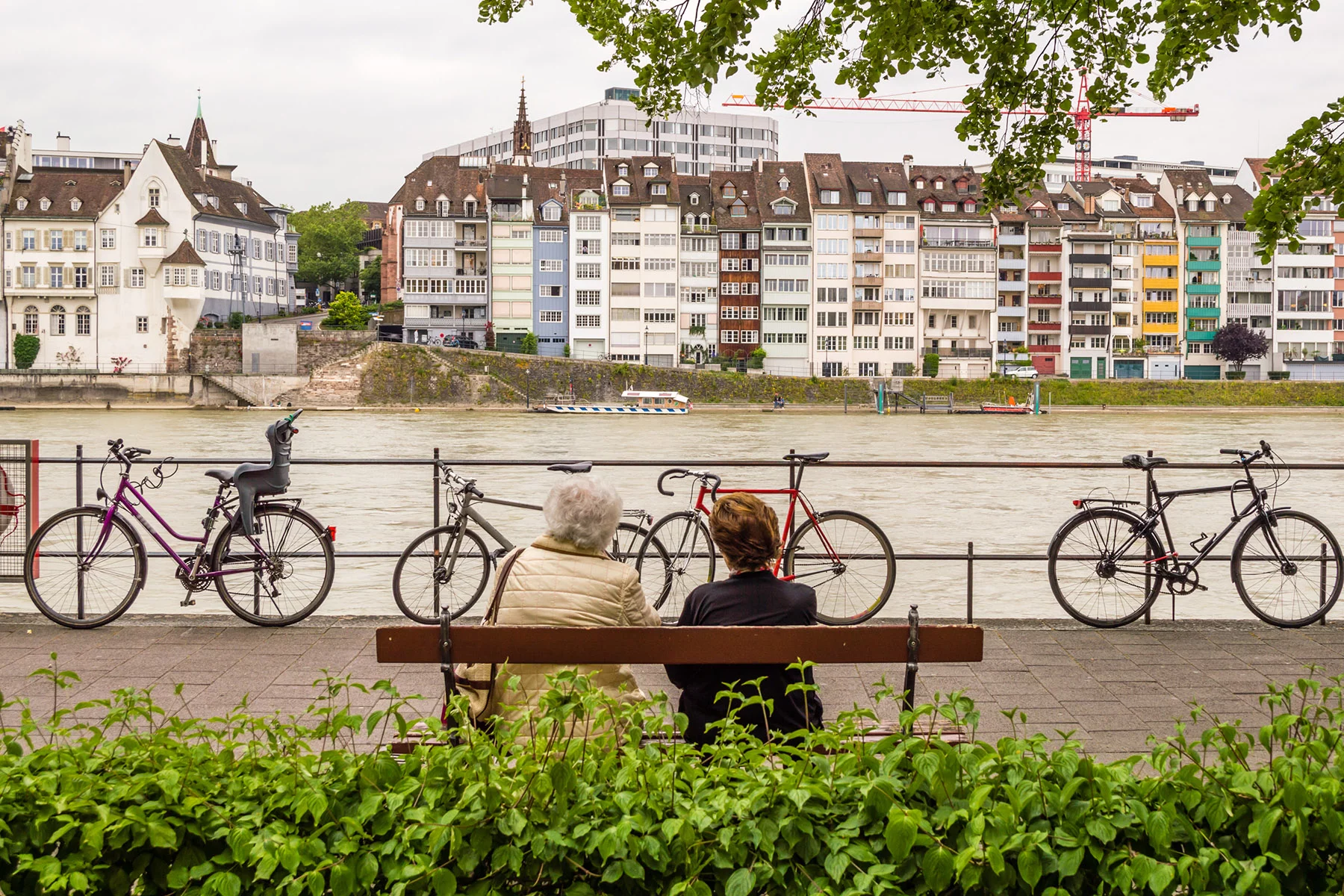With its high quality of life and excellent healthcare system, retiring in Switzerland can be a very comfortable and positive experience for expats. However, if you are relocating to the country, it is crucial that you understand how the Swiss pension works in order to plan a successful retirement.
To help you out, this guide explains everything you need to know about the AHV pension system in Switzerland, including the following:
- The Swiss pension system
- Who is eligible for AHV pensions in Switzerland?
- Pensions in Switzerland for expats
- Swiss pension rates and contributions
- Supplementary pensions in Switzerland
- Non-contributory pensions in Switzerland
- Other pensions in Switzerland
- Applying for your AHV pension in Switzerland
- Pension advice in Switzerland
- Useful resources
Cigna Global
Are you 60+ and looking for private international health insurance? Speak to the healthcare professionals at Cigna Global today and find a policy that’s right for you. They have a global network of doctors, specialists, therapists, and more with tailor-made coverage for seniors. Before starting a new chapter of your life, get peace of mind with Cigna Global.
The Swiss pension system
There are three main pillars to the pension system in Switzerland. The first is the basic state OASI (Old Age and Survivor’s Insurance) which is called the AHV (Alters-und Hinterlassenenversicherung) in German or the AVS (Assurance vieillesse et survivants) in French. Employers and employees both fund the compulsory Swiss social security contributions. The second pillar is based on company pension schemes (Berufliche Vorsorge/Prévoyance Professionelle), which are mandatory for employees who receive a specific salary threshold.

And finally, the third pillar is based on occupational pensions and private investment schemes, which are voluntary. While the first and second pillars are compulsory, many retirees in Switzerland also opt for the third pillar. This can help boost their funding for retirement.
Interestingly, research shows that Swiss pension funds have fared well to market shocks from last year, despite the COVID-19 pandemic. They lost about 8% to 15% of their asset values in 2020, however, these losses are broadly the same as the gains made in 2019, so there should be no “panic”.
You can find more information about choosing the appropriate compensation on the government and AHV websites.
Who is eligible for AHV pensions in Switzerland?
Pension age in Switzerland
If you are a woman retiring in Switzerland, then the statutory retirement age is 64. If you are a man, however, then the age is 65. That said, you may decide to work past the Swiss retirement age. If you choose to do so, though, you must still make compulsory contributions for earnings in excess of CHF 1,400 per month or CHF 16,800 per year.
The Federal Council recently announced four modifications, which will be effective from 2022. The first will be an increase in the retirement age for women, bringing it to 65 for both sexes in the first and second pillars. After this, the increase will be three months every year from 2023 onwards.
Some people may decide to retire earlier than expected. With reference to the first pillar, you can withdraw your AHV pension one or two years ahead of time. However, this will reduce your pension through retirement by 6.8% for one year, or 13.6% for two years.
With regard to the second pillar, you can only retire early if the regulations of your pension fund allow it. Currently, the minimum age for early retirement in Switzerland is 58 years old. However, to bridge the gap until you receive your AHV pension, you can check if your pension fund provides a supplementary pension. Sometimes, employers may already offer this, but if not, then the employee has to take it out on their own.
Who can claim an AHV state pension in Switzerland?
You are entitled to a full pension in Switzerland, as long as you make continuous payments from the age of 20 until retirement for at least 44 years, with an average annual income of CHF 84,600 or more. If not, then you can calculate payments based on the proportion of years that you have worked in the country. Furthermore, if you contribute to the AVS for at least one year, then you can access this pension.
The amount of AHV state pension that you will receive depends on the number of years that you contributed in Switzerland, as well as your average income during the insurance period. Notably, as long as expats continue to contribute to the AVS, they can still receive their pension from the first pillar, even if they no longer live in Switzerland.
What if you’re not eligible for a full pension?
Interestingly, most people who have AHV insurance and pay contributions in Switzerland don’t always reach the maximum AHV pension. To qualify, you must have no AHV contribution gaps and you must be making an annual income of CHF 84,600.
If you are not eligible for a full state pension, then you can, under certain conditions, access supplementary benefits. However, if you are not a resident in Switzerland, then you will not receive these benefits.
Pensions in Switzerland for expats
When planning your retirement in Switzerland, it’s important to think ahead and understand how it works. For instance, many expats don’t realize that they can sometimes receive a refund for their contributions if they aren’t planning to say in Switzerland long-term.

In Switzerland, company pensions are usually paid out as annuity once the person has reached the required retirement age. However, it is a good idea to contact your pension scheme provider before you retire to confirm this.
Unlike company pensions, private Swiss pension funds usually allow you to withdraw the entire amount at once. You can do this as early as five years before, or as late as five years after, you reach the required retirement age. Evidently, planning ahead is an effective way of ensuring that you can simply relax and enjoy your retirement in Switzerland.
Transferring your pension to Switzerland
If you want to transfer your pension to Switzerland, then there are several options to choose from. Essentially, anyone from a country with a bilateral pension agreement with Switzerland can access a Swiss pension, even if they no longer live there. These countries include EU and EFTA member states, Australia, Bosnia and Herzegovina, Canada, Chile, Israel, Japan, Montenegro, North Macedonia, the Philippines, San Marino, Serbia, Türkiye, the United States, and Uruguay. Although it is possible to claim an AHV pension from outside of Switzerland, different conditions apply according to each country.
Notably, with a bilateral agreement in place, you can’t refund or transfer a Swiss pension to another pension scheme. You can only receive it once you reach the full Swiss retirement age. However, if you leave Switzerland, then you can’t make any additional contributions to the AHV pension system. If you also made contributions to a state pension scheme in another country that has a social security agreement with Switzerland, then you may also be able to receive these pension allowances alongside your Swiss pension.
If you’re leaving Switzerland, then you must notify the Swiss pension fund office before you leave. They will then send your application to receive your Swiss pension abroad to the Swiss Compensation Fund for processing. You receive compensation in the currency of your place of residence.
For specialized advice on expat pensions and leaving Switzerland, it’s worth talking to an expert or financial advisor. For example, Chevrolet Consulting can advise you on how best to manage the process.
Chevrolet Consulting
Retiring in Switzerland? Navigating pension rules can be complex. Chevrolet Consulting provides expert advice on occupational benefits and administration. Marcel Chevrolet offers comprehensive guidance, personalized planning, and tax-saving strategies to make your transition to retirement run smoothly.
You can apply for your reimbursement from abroad using an online form found in the Formulare/Allgemeine Verwaltungs formulare section of the AHV Switzerland website. Along with your application, you will also need to supply the following:
- your AHV insurance card
- confirmation of leaving Switzerland
- proof of nationality
- proof of current address
The process can take up to several months and you will receive payments into your personal bank account thereafter.
QROPS: transfer and consolidate your UK pension
Expats moving abroad from the UK may be able to transfer their pensions into a Qualified Recognized Overseas Pension Scheme (QROPS). This allows expats to consolidate their pensions into one plan, helping them to manage their retirement funds more easily and avoid currency fluctuations.
Although there are many advantages to QROPS, they aren’t suitable or available to all UK pensioners, therefore, it is a good idea to seek advice from an expert financial adviser such as AES.
Swiss pension rates and contributions
If you want to find out what your average pension is in Switzerland, then you can use the government’s Swiss pension calculator to calculate the amount. The first pillar, OASI, depends on the number of years that you have contributed, the level of your income, and any contribution credits that you have received for bringing up children or caring for other persons. In this case, both employees and employers must pay contributions, with employee contributions coming directly from the salary.

The occupational pension scheme is mandatory for all employees in Switzerland and starts at the age of 17 when you get your first job. That said, you must earn at least CHF 21,330 per year in order to qualify for it. Again, both employees and employers pay contributions. You can calculate this pension using a conversion rate; at the moment the legal minimum rate is 6.8%.
Finally, the third pillar is the private pension, which comprises savings for retirement. Although this is subject to certain limits, the funds are tax-exempt. There is no obligation to make payments to a third pillar scheme, but some may prefer this method.
It is also compulsory for self-employed individuals over the age of 20 to make contributions to the AHV or OASI. If you are a self-employed worker, then the rate is usually calculated on annual income, which is generally around 7.8%. However, if you earn an annual income of less than CHF 56,400, then this can reduce to 4.2%.
Supplementary pensions in Switzerland
In order to receive supplementary benefits, you must be living in Switzerland. If you’re a foreigner in the country, then you must have lived there without interruption for 10 years. However, this reduces to five years if you’re a refugee or stateless person.
If the first pillar old-age pension and other income aren’t enough to cover your basic needs, then supplementary benefits are available from the Swiss cantons. You can submit applications for supplementary benefits in writing to your canton of residence, usually the cantonal compensation fund office. The benefit amount depends on your individual situation and is calculated on the basis of your recognized expenses and income.

For the second pillar, you accumulate retirement assets with a pension institution, with contributions made by you and your employer. After you retire, this capital converts into an old-age pension using a conversion rate of 6.8%. Pensioners can also receive pensions for children at 20% of the old-age pension. There is also the possibility for early or deferred retirement if the regulations of the pension institution allow it.
Typically, private pension schemes can be accessed earlier than the Swiss retirement age. It is possible to take early withdrawal for matters such as buying a property, whereas many of the unrestricted pension schemes can be accessed at any time.
Non-contributory pensions in Switzerland
Fortunately, benefits from the first pillar scheme apply to the elderly as well as survivors and disabled persons in Switzerland. Therefore, they will receive a pension through the AVS or AI, or have access to certain other invalidity benefits. For unemployed individuals, the contributions are set by calculating assets and income received through social benefits. Therefore, those who meet the minimum contribution period of one year of full payments are then able to draw a Swiss state pension when they reach retirement age.
Other pensions in Switzerland
Survivor’s pension
In the case of death, a surviving spouse, same-sex registered partner, or child may be eligible to access a survivor’s or orphan’s pension in Switzerland. However, this is provided that the deceased paid AHV contributions for at least one year among other conditions.
Fortunately, a partner can receive from CHF 940 to CHF 1,880 per month, while children are entitled to CHF 470 to CHF 940. You can learn more about the requirements for claiming a dependant’s pension on ch.ch. You can also find more information in our guide to estate and inheritance tax in Switzerland.
Invalidity pension
If you have work incapacity of at least 40% for at least one year, then you are entitled to an ordinary invalidity pension. However, this is provided that you demonstrate at least three years of contributions. You can apply for this pension from the age of 18 up to retirement age.
Applying for your AHV pension in Switzerland
In order to claim the AHV Swiss state pension, you will need to submit a written request for your pension withdrawal from where you made your last contribution payment. You can find out more about the appropriate compensation office from the government and AHV websites. However, don’t forget to send your request at least three months before you reach the retirement age in Switzerland. You can find out more about how to apply through the Central Compensation Office.
Pension advice in Switzerland
Of course, it is wise to seek professional financial advice before making any decisions regarding your pension in Switzerland. If you have worked or retired in Switzerland, then you may wonder how much of a pension you can expect to receive as a woman. This is because many women in the country choose to work either part-time or not at all, which can result in a smaller pension. Consequently, there is an ongoing gender gap, which is partly due to how the Swiss pension system works.

Unfortunately, this mainly comes from the unforgiving second pillar which directly reflects the amount someone has worked and how much was paid in during their working life. With this in mind, every year in which little to no contributions have been made will affect the final pension amount. And sadly, boosting your work percentage at a later stage can’t fill the existing gap, either.
Fortunately, the AHV payment, which everyone can access whether they are employed or not, is less affected. That said, because it is no longer possible to live on AHV payments alone, the second pillar pension amount is key. With this in mind, it is important to seek proper financial advice when planning for the future.
Useful resources
- The Swiss Authorities Online – provides further information on the three pillars in the Swiss old-age pension system
- Central Compensation Office – provides information on requesting various pensions in Switzerland
- European Commission – offers more information on old-age benefits in the country
- AHV/IV – an in-depth guide to social security in Switzerland






